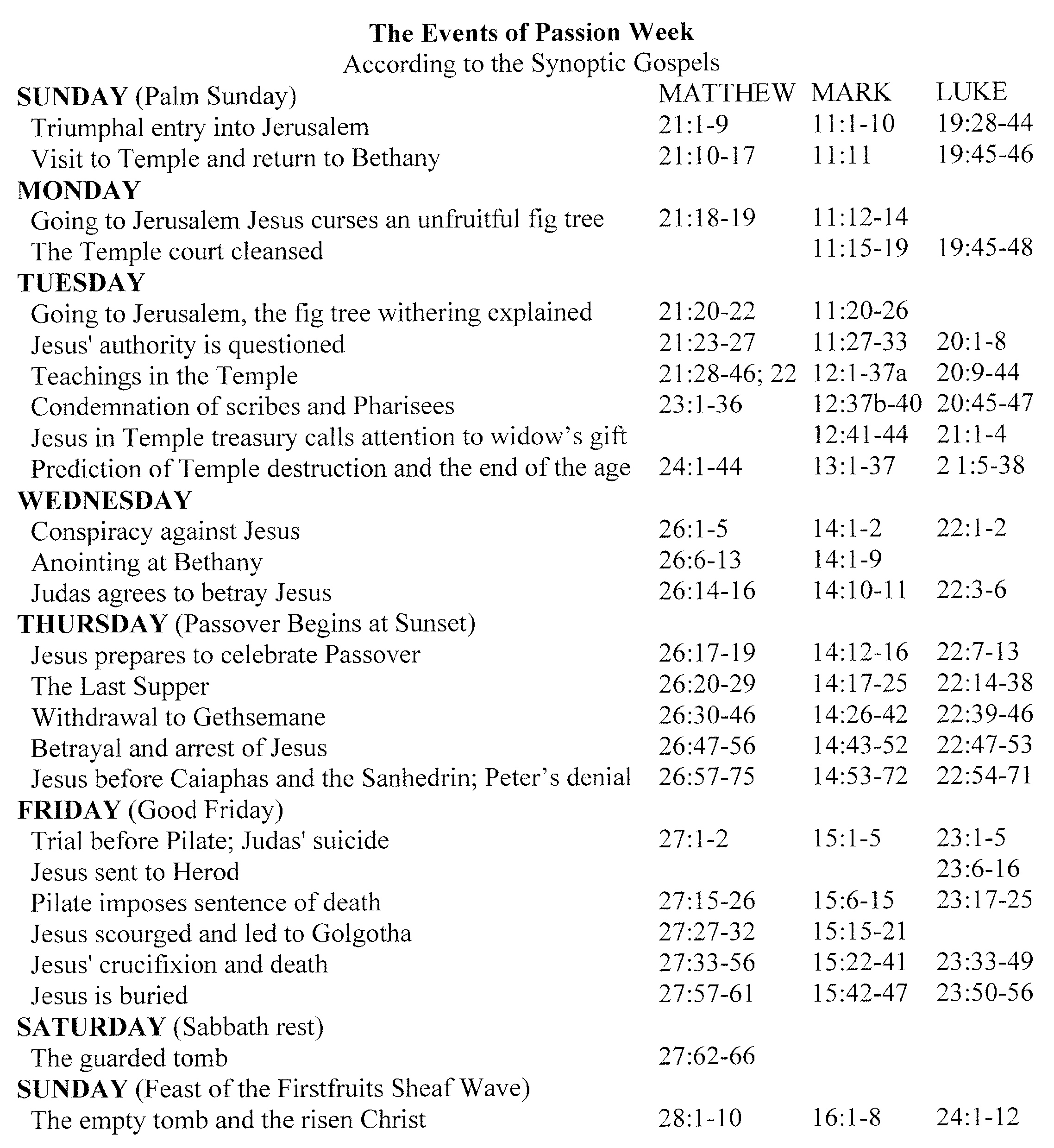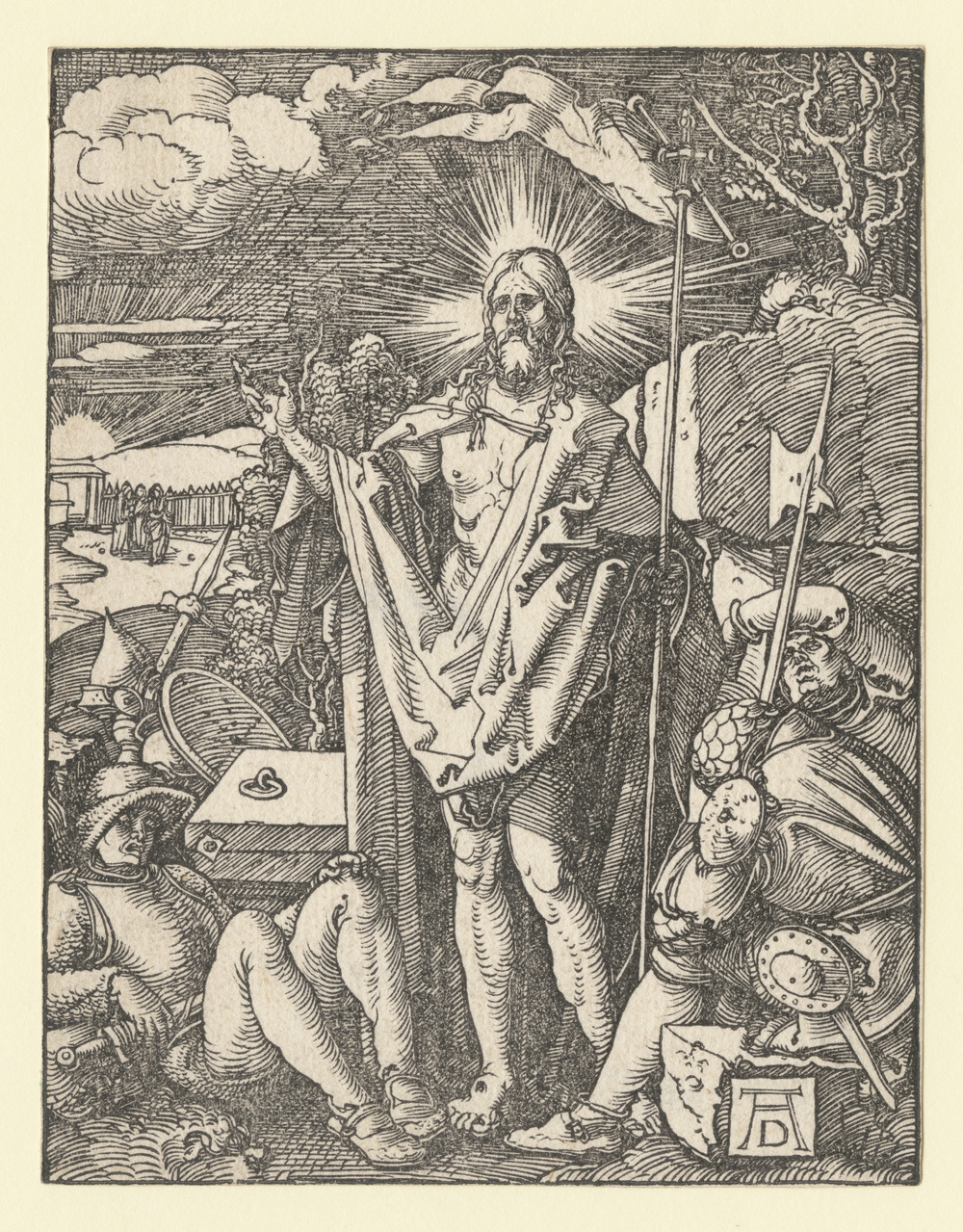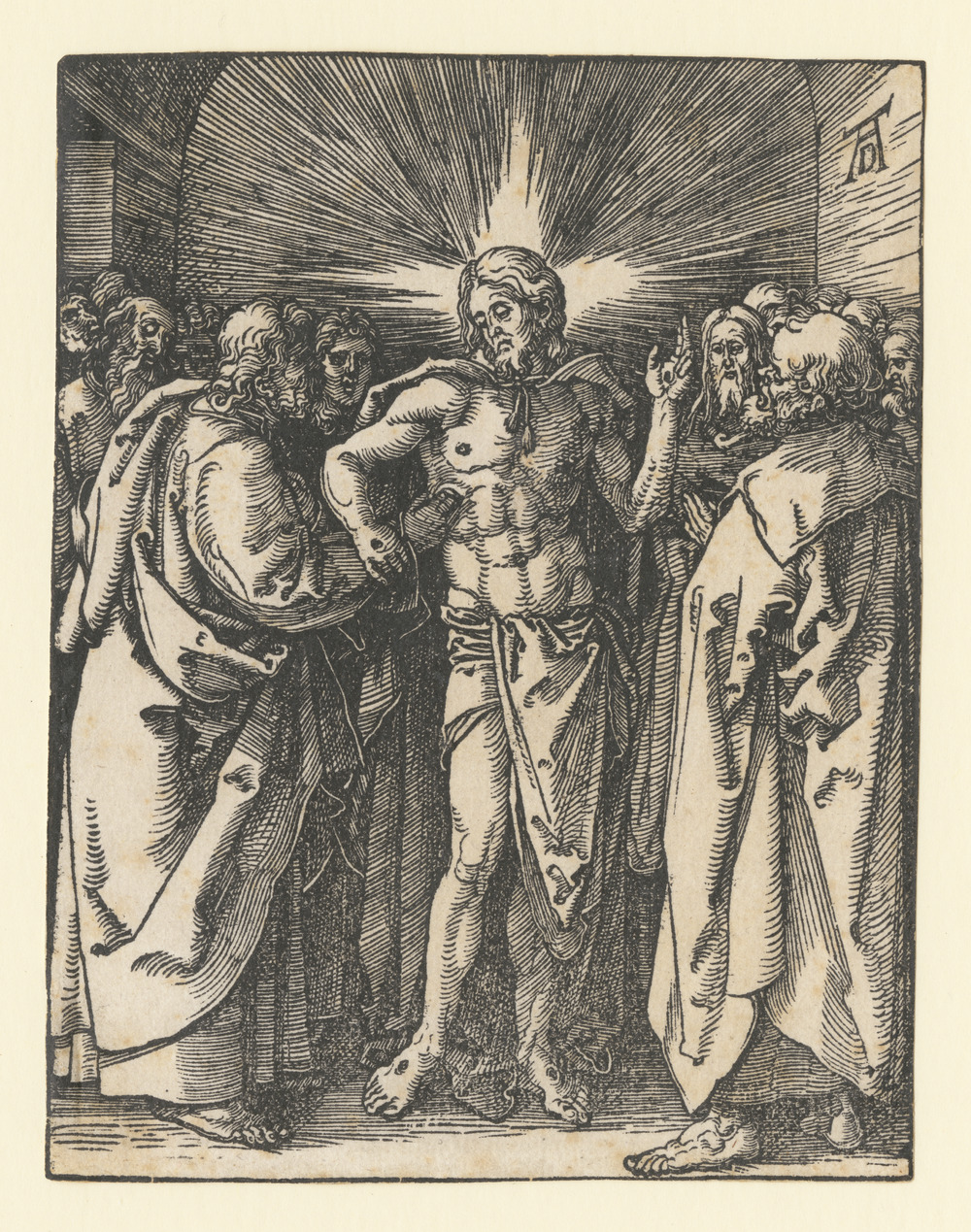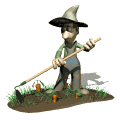I Am Returning To My Father
Comments for Study 25
Pick to read this Bible passage in a separate window.

* An outline of Jesus' last week before his resurrection is as follows.
Friday -Jesus arrives in the Jerusalem area.
Friday -Jesus arrives in the Jerusalem area. (John 11:54-12:1)
Saturday (Sabbath) -a day of rest; no event recorded except Luke 21:37-38.
Sunday -Jesus' triumphal entry. (Matt. 21:1-11; Mark 11:1-10; Luke 19:29-44; John 12:12-19)
Monday -Jesus curses the fig tree (Matt. 21:18-19; Mark 11:12-14). Jesus clears out the Temple. (Matt 21:12-13; Mark 11:15-18)
Tuesday -Jesus' authority questioned. (Matt. 21:23-27; Mark 11:27-33; Luke 20:18) Jesus teaches in the temple. (Matt. 21:28-22:46; Mark 12:1-44; Luke 20:9-21:4) Jesus wept over Jerusalem's leader's unbelief and rejecting him as their King. (Matthew 23:1-39) Jesus anointed at Bethany. (Matt. 26:6-13; Mark 13:3-9; John 12:2-11)
Wednesday -another day of rest; no event recorded except Luke 21:37-38. The Jews plot to kill Jesus. (Matt. 26:14-16; Mark 14:10-11; Luke 22:3-6)
Thursday (Hebrew month Abib the 13th day) -the Passover meal begins at twilight (see below note) when Jesus and the disciples celebrate the Last Supper. (Matt. 26:17-29; Mark 14:12-25; Luke 22:7-20; John 13:1-18) Jesus comforts the disciples (John 14:1-16:33) Jesus prays at Gethsemane. (Matt. 26:26-46; Mark 14:32-42; Luke 22:40-46)
Friday (Hebrew month Abib, 14 day) -According Hebrew time Jesus is arrest and tried from night to daylight. (Matt. 26:47-27:26; Mark 14:43-15:15; Luke 22:47-23:25; John 18:2-19:16) Jesus' crucifixion at 3:00pm, and death before sunset which is the end of the Hebrew day and Passover. (Matt. 27:27-56; Mark 15:16-41; Luke 23:26-49; John 19:17-30) Jesus is buried at sunset. (Matt. 27:57-66; Mark 15:42-47; Luke 23:50-56; John 19:31-42)
Saturday (Sabbath Abib 15, Seven day Feast of Unleavened Bread begins) Jesus' body is in the tomb. He appears in Sheol and accompanies the saints previously dead to heaven.
Sunday (Abib 16; day of First Fruits Sheaf Wave) Jesus' morning resurrection and appearing to the women. (Mark 16:9-11; John 20:11-18) Then he appeared to the two on the road. (Mark 16:12-13; Luke 24:13-35) Then to the ten apostles (no Thomas or Judas) in the evening. (Mark 16:14; Luke 24:36-43; John 20:19-25)
Saturday (Sabbath) -Jesus appears to Thomas and the rest of the apostles. (John 20:26-31)
A week later -Jesus talks and eats with some disciples by the Sea of Galilee. (John 21:1-25)
Forty days since his resurrection -Jesus ascends to his Father from the Mount of Olives. (Matt. 28:15-20; Mark 18:19-20; Luke 24:44-53; Acts 1:1-11)
* The Passover is linked to the 14th day of the month not the day of the week. It starting on Thursday twilight is a very rare event; unusually it starts on a different day of the week. (Hebrew days start at sunset/twilight and go through the night till the next day's sunset.) Falling on a Thursday that year made it possible for Jesus to fulfill the meaning behind the feasts associated with the Passover. His crucifixion was on Friday (still Passover), the Sabbath (Saturday) rest was the Feast of Unleavened Bread, and Sunday was the third day since his death, the day of the First Fruit Wave Sheaf, and the day that Jesus rose from the dead. All three feasts were thus fulfilled by Jesus.
I. The Empty Tomb (1-9)
>1. On which of the women who went to the tomb early Sunday morning does John focus? (1a; Mt. 28:1; Lk. 24:10)
* After the Sabbath, at dawn on the first day of the week, Mary Magdalene and the other Mary went to look at the tomb." -Matthew 28:1
* "It was Mary Magdalene, Joanna, Mary the mother of James, and the others with them who told this to the apostles." -Luke 24:10
* "Early on the first day of the week, while it was still dark, Mary Magdalene went to the tomb and saw that the stone had been removed from the entrance." -John 20:1
* The Scofield Reference Bible (Cyrus I. Scofield, 1909 & 1917) organizes the women's visits like this: "Three women, Mary Magdalene, and Mary the mother of James, and Salome, start for the sepulchre, followed by other women bearing spices. The three find the stone rolled away, and Mary Magdalene goes to tell the disciples (Lk. 23:55-24:9; John 20:1-2). Mary, the mother of James and Joses, draws nearer the tomb and sees the angel of the Lord (Mt. 28:2) She goes back to meet the other women following with the spices. Meanwhile Peter and John, warned by Mary Magdalene, arrive, look in, and go away (John 20:3-10). Mary Magdalene returns weeping, sees the two angels and then Jesus (John 20:11-18), and goes as He bade her to tell the disciples. Mary (mother of James and Joses), meanwhile, has met the women with the spices and, returning with them, they see the two angels (Lk. 24:4-5; Mk. 16:5). they also receive the angelic message, and, going to seek the disciples, are met by Jesus (Mt. 28:8-10).
* Mary Magdalene was the one from whom the Lord had cast seven demons. (Luke 8:1-5)
* "early of the first day of the week" -Sunday. The first first day of the week (Sunday) after the Passover was the Feast of the Sheave Wave First Fruit. This feast foreshadowed Jesus resurrection and his presentation to his Father.
* "while it was still dark" -She left for the tomb just before the sun rose. The Hebrew 24 hour day starts at sunrise.

* A woodcut by Dürer, Albrecht (1471-1528) titled "Die Fußwaschung" created from 1504-1514. An alternative title is, "The Resurrection".
This was originally in "The Small Passion". Dürer's depiction of the resurrection of Christ focuses on Matthew's account: Christ emerges from the tomb while the guards shook in fear and became as dead men.
Dürer's Small Passion originally contained thirty-six woodcuts, plus a title page. Some woodcuts include the life of Christ from the Gospels: the washing of Peter's feet (John 13:1-16), the crowning of thorns (Matthew 27:29; Mark 15:17; John 19:2), the resurrection (Luke 24:1-12; John 20:1-23), the meeting of the disciples on the road to Emmaus (Luke 24:13-35), the doubting Thomas episode (John 20:24-29), The Crucifixion, and a later impression (circa 1580-1600) of The Martyrdom of Saint Catherine (Nuremberg, 1498).
Courtesy of the Digital Image Archive, Pitts Theology Library, Candler School of Theology, Emory University: http://www.pitts.emory.edu.
>2. Where had she been during the crucifixion and burial? (19:25, 40-42; Lk. 23:55)
* "The women who had come with Jesus from Galilee followed Joseph and saw the tomb and how his body was laid in it." -Luke 23:55
* "Near the cross of Jesus stood his mother, his mother's sister, Mary the wife of Clopas, and Mary Magdalene." -John 19:25
* "Taking Jesus' body, the two of them wrapped it, with the spices, in strips of linen. This was in accordance with Jewish burial customs. At the place where Jesus was crucified, there was a garden, and in the garden a new tomb, in which no one had ever been laid. Because it was the Jewish day of Preparation and since the tomb was nearby, they laid Jesus there." -John 19:40-42
>Why did she go to the tomb? (Mk. 16:1)
* "When the Sabbath was over, Mary Magdalene, Mary the mother of James, and Salome bought spices so that they might go to anoint Jesus' body." -Mark 16:1
* John did not expound upon the other events because they were not important to what he was saying.
>3. What did she notice? (1b)
* "Early on the first day of the week, while it was still dark, Mary Magdalene went to the tomb and saw that the stone had been removed from the entrance." -John 20:1
* She was very faithful to Jesus.
* "anoint Jesus' body" -Not required by the law. She did this out of love and respect.
* Perhaps she remembered what Jesus said when the other Mary, Lazarus' sister point oil on Jesus' feet.
>What did she do? (2a)
* "So she came running to Simon Peter and the other disciple, the one Jesus loved," -John 20:2a
* Mary felt comfortable going to the apostles. She even expected them to do something.
* "running" -she was emotionally stirred.
* "Simon Peter" -mentioned because perhaps she recognized him as the leader.
>What conclusion did she draw? (2b)
* "and said, 'They have taken the Lord out of the tomb, and we don't know where they have put him!'" -John 20:2b
* "they" -She concluded that someone had removed and/or stolen the body.
* "we" -the other women with her.
* She did not think that Jesus had risen from the dead. It did not occur to her.
* Psalm 77
* Her reaction is typical of one who may believe in Jesus but not have resurrection faith yet.
>Notice how John identifies himself? (2; 19:26)
* "the one Jesus loved" -John 20:2, 19:2b
>Why do you think he spoke of himself this way?
* He personally experienced Jesus' love.
* Not so much that Jesus loved him more than the others, but because he knew Jesus loved him.
* Humility is shown by not using his name.
>5. How did Peter and John react? (3)
* "So Peter and the other disciple started for the tomb." -John 20:3
* John was with Jesus to the end of the burial.
* Peter tried to stay to the end, but left after he denied Jesus the third time.
>What does this show us about the character of each one? (4-7a)
* "Both were running, but the other disciple outran Peter and reached the tomb first. He bent over and looked in at the strips of linen lying there but did not go in. Then Simon Peter, who was behind him, arrived and went into the tomb." -John 20:4-7a
* "Both were running" -they were excited and anxious; not because of hope and faith, because of fear.
* "the other disciple outran Peter" -Peter was a young man. Peter was older.
* "bent over and looked in" -He did not go in perhaps because what he saw was enough or he had respect for Peter.
* "Simon Peter... went in" -He was always bold and a man of action.
* "Finally the other disciple... also went inside" -John didn't want to be outdone by Peter?
>6. What did John observe inside the tomb? (7b-9)
* "He saw the strips of linen lying there, as well as the burial cloth that had been around Jesus' head. The cloth was folded up by itself, separate from the linen. Finally the other disciple, who had reached the tomb first, also went inside. He saw and believed. (They still did not understand from Scripture that Jesus had to rise from the dead.)" -John 20:7b-9
>What was puzzling about the strips of linen and the burial cloth that had been around Jesus' head?
* "lying there... folded" -The linen was wrapped according to tradition with oil thus making it very hard to unwrap. It was not unwrapped it was lying there as though Jesus' body had passed through it. The head cloth was folded and lying neatly in the corner. Grave robbers would not do take all this off and then fold it.
* Jesus resurrection is the first resurrection under one's own power.
* Jesus did not need clothes in his resurrected body.
>7.What did John think about what he saw? (8)
* "Finally the other disciple, who had reached the tomb first, also went inside. He saw and believed." -John 20:8
* He believed that Mary's words were correct. Perhaps he even believed that Jesus rose from the dead. Perhaps he remembered Jesus continually words that he would be raised on the third day. Perhaps he saw the priest's presenting the sheave to the Lord at the temple by waving it for the feast.
>What does the author's parenthetical comment mean? (9)
* "(They still did not understand from Scripture that Jesus had to rise from the dead.)" -John 20:9
* Jesus' resurrection was in the flesh, in the same body he had when he was crucified.
* "They" -Peter and John
* "from Scripture" -this does not include the fact that Jesus had been telling them all along.
* Our faith needs to be based on the word of God.
II. Jesus Appears to Mary Magdalene (10-18)

>8. After the disciples went home, what did Mary do? (10-12)
* "Then the disciples went back to their homes, but Mary stood outside the tomb crying. As she wept, she bent over to look into the tomb and saw two angels in white, seated where Jesus' body had been, one at the head and the other at the foot." -John 20:10-12
* "They asked her, 'Woman, why are you crying?'" -John 20:13a
* "the disciples went back to their homes" -They didn't know what else to do.
* "stood outside the tomb crying" -She was full of sorrow. The power of death was over her.
* "She bent over to look in the tomb" -She had not done this before. She did as the two apostles did.
* "saw two angels in white seated where Jesus' body was" -It didn't dawn on her that Peter and John had not seen them.
* Their questions should have made her think. She didn't need to cry.
>What reason did Mary give for crying? (13b)
* "'They have taken my Lord away,' she said, 'and I don't know where they have put him.'" -John 20:13b
* "they" -didn't blame the angles. Most likely she didn't even know they were angles.
* Mary's life problem had been solved, but she still needed to grow in faith.
>9. Why didn't she recognize him? (14)
* "At this, she turned around and saw Jesus standing there, but she did not realize that it was Jesus." -John 20:14
* Mary's eyes were clouded with tears and women did not look at men directly in that society. She was in shock. She didn't think he had risen. Human sorrow, the fear of death can cloud our judgement.
>When Jesus spoke to her how did she answer? (15)
* ""Woman," he said, "why are you crying? Who is it you are looking for?" Thinking he was the gardener, she said, "Sir, if you have carried him away, tell me where you have put him, and I will get him." -John 20:15
* He understood and loved her. He was graceful to her.
>10. What does this scene reveal about Jesus? (16a)
* "Jesus said to her, "Mary." She turned toward him and cried out in Aramaic, "Rabboni!" (which means Teacher)." -John 20:16
* Jesus appearing to her was truly grace.
>When did she recognize him? (16b)
* "Jesus said to her, "Mary." She turned toward him and cried out in Aramaic, "Rabboni!" (which means Teacher)." -John 20:16
* A stranger wouldn't know her name.
* When we call someone by name we want their full attention.
* "turn toward him" -She had not been looking at him. This is the second time she turned toward him (14). She must have kept her head down.
* Jesus said he calls his sheep by name.
>11. What mission did Jesus give Mary? (17)
* "Jesus said, "Do not hold on to me, for I have not yet returned to the Father. Go instead to my brothers and tell them, 'I am returning to my Father and your Father, to my God and your God.'" -John 20:17
>What did this message mean?
* "my brother" -Shows our relationship to him.
* "I have not yet returned to the Father" -After this Jesus went to the presence of God the Father to present himself as the first fruit in fulfillment of the Feast of Wave Sheave.
* "Go instead" -he gave her a mission and direction.
* "my Father and your Father"
* "my God and your God"
* Jesus could say this about them and us even after they had all deserted him.
>What was the good news she told them? (18)
* "Mary Magdalene went to the disciples with the news: "I have seen the Lord!" And she told them that he had said these things to her." -John 20:18
III. My Lord and My God (19-23)

>1. Where were Jesus' disciples? (19a)
* "On the evening of that first day of the week, when the disciples were together, with the doors locked for fear of the Jews," -John 20:19a
* "On the evening of the first day of the week" -Sunday night, the day of his resurrection. Nothing is said of Jesus between morning and night because he had gone to his Father.
* "the disciples were together" -When Jesus was arrested they were scattered, but here they are together again, perhaps the upstairs room where they had the last supper. (Acts 1:13)
* "doors locked" -Fear do to disbelief in the resurrection. Also uncertainty, doubt, humility, disillusion, and despair.
>Why were they so fearful?
* Fear of the Jews.
* Fear for their life.
* They did not accept Mary's words.
* Even John must have not said much, if anything about his conviction of Jesus' resurrection.
>How did Jesus get in? (19b)
* "Jesus came and stood among them and said, 'Peace be with you!'" -John 20:19b
* His resurrection bodies passed through the walls.
* His resurrection body had not limitation of time and space.
* 1 Corinthians 15
* This miracle is no different than him walking on water, feeding the five thousand, and raising the dead.
>How was his greeting more than a greeting?
* "...and said, 'Peace be with you!'" -John 20:19b
* Peace is the opposite of fear.
* "Peace be with you" -Shalom in Hebrew. Genesis 2:7
>Why did he show them his hands and side? (20a)
* "After he said this, he showed them his hands and side." -John 20:20a
* To prove it was him in the same body he was crucified in.
>And how did they respond? (20b)
* "The disciples were overjoyed when they saw the Lord." -John 20:20b
* "The seventh angel sounded his trumpet, and there were loud voices in heaven, which said: "The kingdom of the world has become the kingdom of our Lord and of his Christ, and he will reign for ever and ever." -Rev 11:15
* They responded like little children on Christmas morning. With reverence and joy.
>3. What mission did Jesus give them? (21) Compare with John 3:16.
* "Again Jesus said, "Peace be with you! As the Father has sent me, I am sending you." -John 20:21
* Jesus wanted them to do as he had done.
* "For God so loved the world that he sent his one and only Son that whoever believes in him shall not perish but have eternal life." -John 3:16
* They had a great reason to go.
>How is the disciples' mission similar to the mission God gave Jesus? (22)
* "And with that he breathed on them and said, 'Receive the Holy Spirit.'" -John 20:22
* This reminds us of Genesis when God breathed into the first man the breath of life. (Genesis 2:7)
* Follows God's pattern to multiply and take care of.
>4. How did he equip them? How is forgiveness related to the mission of the disciples? (23; Rom. 8:11, 15)
* "'If you forgive anyone his sins, they are forgiven; if you do not forgive them, they are not forgiven.'" -John 20:23
* "And if the Spirit of him who raised Jesus from the dead is living in you, he who raised Christ from the dead will also give life to your mortal bodies through his Spirit, who lives in you." -Romans 8:11
* "For you did not receive a spirit that makes you a slave again to fear, but you received the Spirit of sonship. And by him we cry, 'Abba, Father.'" -Romans 8:15
* Relationship with God is assured. Peace with and of God.
* Preach of God's love and forgiveness and grace.
>Why must a disciple of Jesus be a man or woman of mission?
* Jesus gave us this direction.

* A woodcut by Dürer, Albrecht (1471-1528) titled "Die Fußwaschung" created from 1505-1515. An alternative title is, "The Resurrection".
This was originally in "The Small Passion". Dürer's depiction of the resurrected Jesus as Thomas touches the pierced side of Jesus while the apostles gather around.
Dürer's Small Passion originally contained thirty-six woodcuts, plus a title page. Some woodcuts include the life of Christ from the Gospels: the washing of Peter's feet (John 13:1-16), the crowning of thorns (Matthew 27:29; Mark 15:17; John 19:2), the resurrection (Luke 24:1-12; John 20:1-23), the meeting of the disciples on the road to Emmaus (Luke 24:13-35), the doubting Thomas episode (John 20:24-29), The Crucifixion, and a later impression (circa 1580-1600) of The Martyrdom of Saint Catherine (Nuremberg, 1498).
Courtesy of the Digital Image Archive, Pitts Theology Library, Candler School of Theology, Emory University: http://www.pitts.emory.edu.
>5. Who was Thomas? (24; Mk. 3:18)
* "Andrew, Philip, Bartholomew, Matthew, Thomas, James son of Alphaeus, Thaddeus, Simon the Zealot" -Mark 3:18
* "Now Thomas (called Didymus), one of the Twelve, was not with the disciples when Jesus came." -John 20:24
>What was Thomas' spiritual problem? (25; 11:16; 14:1-6)
* "Then Thomas (called Didymus) said to the rest of the disciples, 'Let us also go, that we may die with him.'" -John 11:16
* "'Do not let your hearts be troubled. Trust in God; trust also in me. In my Father's house are many rooms; if it were not so, I would have told you. I am going there to prepare a place for you. And if I go and prepare a place for you, I will come back and take you to be with me that you also may be where I am. You know the way to the place where I am going.' Thomas said to him, 'Lord, we don't know where you are going, so how can we know the way?' Jesus answered, 'I am the way and the truth and the life. No one comes to the Father except through me.'" -John 14:1-6
* "So the other disciples told him, 'We have seen the Lord!' But he said to them, 'Unless I see the nail marks in his hands and put my finger where the nails were, and put my hand into his side, I will not believe it.'" -John 20:25
* Thomas was a very practical man.
* doubt, defiant, stubborn, always negative, didn't listen well, loyal, faithful, lived by "seeing is believing"
>6. When did Jesus appear to his disciples again? (26)
* "A week later his disciples were in the house again, and Thomas was with them. Though the doors were locked, Jesus came and stood among them and said, 'Peace be with you!'" -John 20:26
* "A week later" -On the Sunday after his resurrection. Nothing is said of Jesus appearing since the Sunday before.
* "doors were locked" -again showing their fear
>How did he help Thomas? (27)
* "Then he said to Thomas, "Put your finger here; see my hands. Reach out your hand and put it into my side. Stop doubting and believe." -John 20:27
* Perhaps Thomas thought no one would hear him say this.
* Jesus loved him. He didn't rebuke him. He gave him the proof he asked for.
>What was Thomas' confession? (28)
* "Thomas said to him, "My Lord and my God!" -John 20:28
* Jesus accepted Thomas' claim that Jesus is God.
>7. What blessing does Jesus give to us who have not seen Jesus with physical eyes, but have read the book and believed in Jesus? (29)
* "Then Jesus told him, "Because you have seen me, you have believed; blessed are those who have not seen and yet have believed." -John 20:29
* Jesus said we are blessed when we call him our Lord and our God.
>8. What do we know about what the risen Jesus did for the disciples? (30)
* "Jesus did many other miraculous signs in the presence of his disciples, which are not recorded in this book." -John 20:30
>What does verse 31 teach us about the way and content of believing?
* "But these are written that you may believe that Jesus is the Christ, the Son of God, and that by believing you may have life in his name." -John 20:31

|























